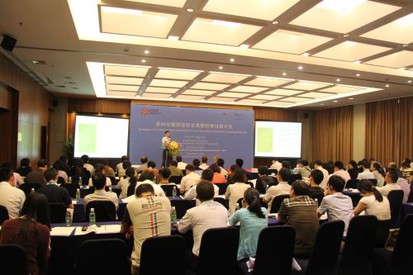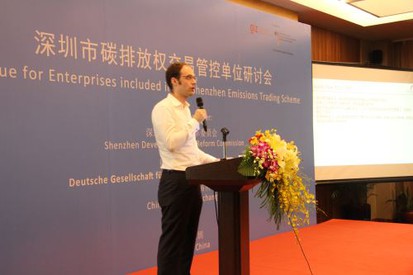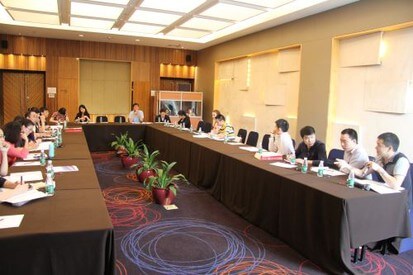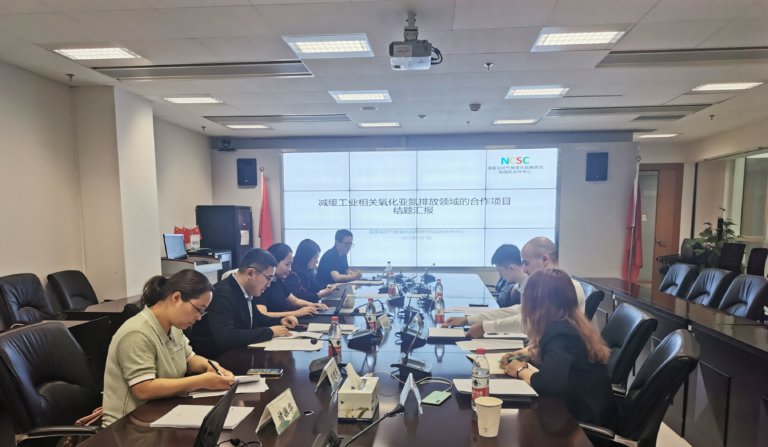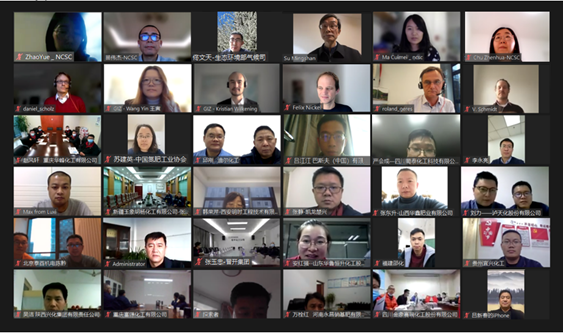13 May 2014 – Together with Shenzhen Carbon Exchange and the Shenzhen-DRC, GIZ co-hosted the Shenzhen dialogue for enterprises as an opportunity for participating enterprises to strengthen their knowledge on carbon asset management through the exchange of experience between international and national experts. With over 90 participants, the Shenzhen dialogue provided local participants with the opportunity to learn from international experiences and to voice their concerns and questions regarding the existing scheme.
The two international guest speakers, Mr Maartin Neelis, Regional Manager China of Ecofys, and Mr Casper Chiquet, Head of Implementation of South Pole Advisory, shared their international experiences regarding carbon asset management. Mr Neelis provided advice for carbon asset management based on their own past experience with the EU ETS. Mr Chiquet took a more financial approach, where he introduced the use of an investment price curve, helping decision making regarding long-term investments depending on the current carbon price. Both presentations provided insight into understanding more effective methods in which to operate within the emission trading scheme. Questions were raised by the participants at the end of each section, to help further adaptation of these methods into their own company’s operations.
In addition to experience sharing, the dialogue also covered topics regarding the factors influencing the market price, the expected development and current structure of the Shenzhen scheme, as well as information regarding the usage and management of CCERs.
To further enhance the exchange of information and to discuss the current concerns amongst the local industries themselves, the afternoon proceeded through splitting into the three focus groups based on the key industries in Shenzhen: the tele-communications industry, the power industry and the information technology industry. Each focus group had both national experts hosting the discussion group as well as an international expert contributing to the exchange. It allowed participants to more easily express their questions and concerns, and to understand the situation of other enterprises within the same industry. It was a platform in which they could discuss and exchange ideas on how to tackle the issues they are jointly facing.
The Telecommunications industry focused on more practical questions regarding the regulations and compliance of the Shenzhen pilot scheme. Questions raised included emission coverage, use of CCERs, allocation methods and more. However, towards the end of the session, more general questions were raised, seeking insight into the future developments of the Shenzhen pilot scheme and what are the actual effects of carbon trading on an enterprise.
The Power sector dived straight into discussing the individual problems of each enterprise. At the end of the discussion, it was clear that many enterprises were facing the same issues, all having different variations of the same problem. The perception of unrealistic or unfair base for quotas was one of the many issues discussed, as so called early bird actions were seemingly not put into consideration concerning allocations. In addition, changes in the sources of the energy were discussed as a factor they believe should be also put into consideration. However, the biggest issue discussed was the difference between the officially calculated heat values by NDRC and the internally calculated heat values by enterprises themselves. The difference caused increased difficulties for enterprises to plan for the compliance period.
For the Information Technology industry, after a short introduction of the current situation in the sector, the participants engaged in a discussion regarding the perceived fairness of the allowance allocation method. An issue being that the carbon intensity targets allocated seemingly didn’t reflect the actual emissions, causing enterprises to struggle through the compliance period. This issue of perceived fairness revealed problems on both the government and company side, where since the calculation method of the carbon intensity is undisclosed, enterprises inquired after the apparent transparency of the process. In addition, though allocations were distributed early last year, enterprises may not have taken it seriously into account until the end of the compliance period. This highlighted that there was a potential lack of essential knowledge regarding the ETS throughout this period, which lead to the suggestion of increasing communication between the Shenzhen-DRC and Shenzhen Carbon Exchange and the participants, so that compliance principles can be actively learnt to avoid future potential losses amongst companies.
With the good turnout for this dialogue, GIZ has planned another session involving different industries and participants. This session will be help in September.

